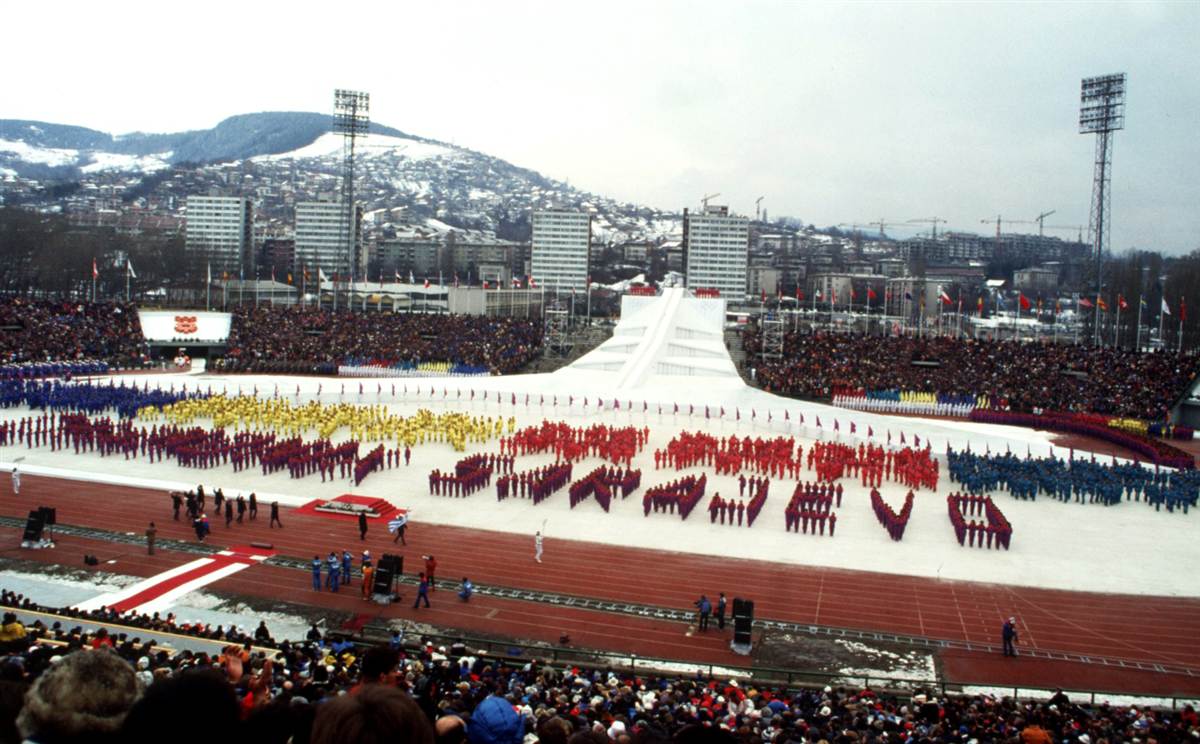SARAJEVO- a perfect place for winter activities
Let us firstly see why Sarajevo, the capital of Bosnia and Herzegovina, was chosen to represent the whole ex. Yugoslavian Kingdom (Bosnia and Herzegovina, Croatia, Slovenia, Macedonia, Montenegro and Serbia) in 1984. Winter Olympics Games. The answer is very simple and there are many aspects to conclude easily. Sarajevo has an altitude of 500m above the sea level and it is a located in a valley among 4 large mountains (Bjelašnica, Trebević, Igman, Jahorina). All of them were used for winter sport activities. Yugoslavian Kingdom was a very strong economic and political kingdom, that could host big world events, as Olympic Games at that time. Also, geographically, Sarajevo was situated in the middle of ex. Yugoslavian Kingdom. The city where all different nationalities would meet, providing a multi-national concept, spirit and harmony among varieties.
A great representative of ex. Yugoslavian Kingdom was chosen in front of Gothenburg, Sweden and Sapporo, Japan to host the XIV Winter Olympic Games in 1984. One of the main reasons was also the great climate of Sarajevo, most precisely perfect temperature for winter sports and long hours of day light, comparing it with Gothenburg or Sapporo cases. It also included 12 more countries than previous Winter Olympic events, gathering strong media attention and known as best organized Winter Olympic Games until the year of 1984.
IMPROVEMENT OF SARAJEVO
At that time, Sarajevo got a chance to improve as a city, with further infrastructure development and growth. Two Olympic villages were built, Dobrinja and Mojmilo, as a clear example of a communist style neighborhoods, where largest municipality is situated today. The mountains around Sarajevo got new roads, modern hotels and even cable cars, as well as the improvement of domestic airport. Sarajevo became the center of the world and important representative of Balkan peninsula for the visitors of 1984. Winter Olympic Games.
SPORT EVENTS AND FACILITIES
Sarajevo managed to hold 6 different sports and 10 disciplines. A total of 1272 athletes were competing on 39 events. The ceremony was opened on the Olympic Stadium Koševo on 7th of February 1984. with a burning Olympic flame. The stadium was constructed right before the Olympic Games event started and still used today for athletic and football events of local clubs and teams.
As mentioned previously, Sarajevo is surrounded with 4 Olympic mountains, the Bjelašnica, Igman, Trebević and Jahorina mountains. Bjelašnica was used for men alpine skiing, while Jahorina for women alpine skiing. Both mountains are today used by locals for recreational skiing. On Trebević, a great bob-sleigh track was constructed by most significant architectures of ex. Yugoslavian Kingdom. A mountain used for bobsled sport events, reachable by new cable car
starting from the Old Town of Sarajevo. Nowadays, locals and tourists use the mountain for hiking trails and mountain biking, but also to walk on the bob-sleigh track. The track remained damaged from 1992-1995 siege of Sarajevo and today serves as symbol of Sarajevo, on which visitors can walk or perform street art exhibitions on its walls. Igman mountain had most number of Olympic disciplines, the Ski jumping, Nordic skiing and Biathlon. Today, visitors can use only a skiing track and easy walking paths around the mountain.
Besides the mountains, Sarajevo has two Olympic Halls, the Skenderija and Zetra (Juan Antonio Samaranch) halls. Both used for ice hockey and ice skating events during the Winter Olympic Games. Skenderija was built in 1966., while Zetra in 1978., known as the most expensive infrastructural project in Sarajevo. The Olympic Halls of Sarajevo today are used for games and events of the Basketball, Tennis, Indoor-football and Hockey National teams of Bosnia and Herzegovina.
JURE FRANKO AND SONG OF ‘JUREK-BUREK’
Out of 49 countries that were competing during the Sarajevo Winter Olympic Games, Soviet Union was the most successful, winning 25 gold, silver and bronze medals. Second was East Germany with a number of 24 medals and third Finland with a number of 13 medals. Yugoslavia, as the host, won only one medal in men alpine skiing discipline. The silver medal was won by Jure Franko (Slovenian) that made whole Yugoslavia very proud. In Sarajevo, still the famous song from Winter Olympics is gratefully remembered, which sounds ‘Volimo Jureka, više od Bureka’. In translation, ‘We love Jurek, more than Burek’. Burek is the second most common national dish, known as a pastry pie filled with beef meet and onions, served in rounded shape and topped with special white cream. Surely, Jure Franko left a great memory for all Yugoslavs.
VUČKO – THE OLYMPIC MASCOT
‘Vučko’ became the mascot of Sarajevo Winter Olympics. It was created by Jože Trobec, a Slovenian artist, who used a wolf picture to draw it. Vučko is an illustrative charicature of a wolf with a rounded nose that symbolizes the shape of a snow ball. It became greatly accepted among Yugoslavian society and today it serves as one of the main symbols of Sarajevo. Entering any souvenir shop in Sarajevo, Vučko will be presented on each corner of it in different sizes and colors. Make sure to buy one while visiting Sarajevo!
OLYMPIC MUSEUM IN SARAJEVO
The day after the opening ceremony of Sarajevo Winter Olympic Games, precisely on 8th of February 1984., Sarajevo became richer for one new museum. The Sarajevo Olympic Museum is located in the city center of Sarajevo. It was built to preserve the memory of the Olympic Games, surely the largest historical event of sports in the country. The facility was designed by Karl Paržik in 1903., a Czech architect. The museum is still open today and brings the most positive memories of Sarajevo history, so make sure to visit it while exploring the city.
1984 SARAJEVO OLYMPIC TOUR
If wondering how to visit all main Olympic spots in Sarajevo, we have the answer. Do not hesitate to book an Olympic tour with us and make your memories unforgettable with a help of our official tour guides from Bosnia and Herzegovina.

